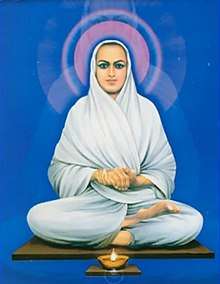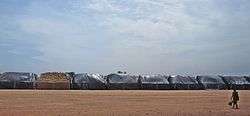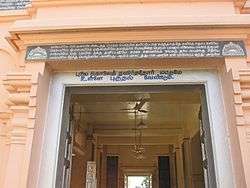Ramalinga Swamigal
Arutprakasa Vallalār Chidambaram Ramalingam (5 October 1823 – 30 January 1874), whose pre-monastic name was Rāmalingam, commonly known in India and across the world[1] as Vallalār, also known as Ramalinga Swamigal and Ramalinga Adigal, was one of the most famous Tamil Saints and also one of the greatest Tamil poets of the 19th century[2] and belongs to a line of Tamil saints known as "gnana siddhars" (gnana means higher wisdom).
Chidambaram Rāmalingam | |
|---|---|
 Ramalinga Swamigal | |
| Born | 5 October 1823 |
| Disappeared | 30 January 1874 (aged 50) Mettukuppam, a hamlet near Vadalur, Cuddalore District, Tamil Nadu, India |
The Samarasa Suddha Sanmarga Sathiya Sangam[3] was spread and passed on by him not only in theory but mainly in practice by his own way of living which by itself is an inspiration for his followers. Through the notion of Suddha Sanmarga Sangam, the saint endeavored to eliminate the caste system.[4] According to Suddha Sanmarga, the prime aspects of human life should be love connected with charity and divine practice leading to achievement of pure knowledge.
Ramalinga advocated the concept of worshipping the flame of a lighted lamp as a symbol of the eternal Power.[5]
Early life
Rāmalingam's parents were Rāmayyā pillai and Chinnammai. She was his sixth wife, as all his previous wives had died childless and in quick succession. They were a family in Marudhur, a village in the old South Arcot district, near Chidambaram. Rāmalingam was their fifth child. The older ones were two sons Sabhapati and Parasu Rāman; and two daughters, Sundarammal and Unnamulai. They named their youngest child Rāmalingam.
Childhood and divine experiences
Once, Rāmalingam's parents went to the Chidambaram Natarājar Temple with their five month old child, and the infant was joyous while the priest was offering Deepa aradhana (adoration by lighted lamp being brought close to the vigrahams); this was perceived by Rāmalingam as a deep spiritual experience. In later years he said of the experience:
- "No sooner the Light was perceived, happiness prevailed on me", and
- "The sweet nectar was tasted by me as soon as the Arut perun jothi (Supreme Grace Of Light) became visible".[6]
In 1824, his father Rāmayyā pillai died. Because of his untimely demise, Chinnammai shifted her residence to her mother's place at Chinna kāvanam, Ponneri. Saint Rāmalingam was a small child when he relocated with his mother to Chennai in 1826. He and his mother lived with his eldest brother Sabhapati and his wife Pāppāthi at 31/14 Veerasamy Pillai Street at Sevenwells area of Chennai, which is in the area near Chennai Kandha kottam Kandha swāmi temple. After Rāmalingam reached five years of age, Sabhapati initiated his formal education. But the young child was not interested in that, instead he preferred trips to the nearby Kandha swāmi temple. Sabhapati thought that the child needed punishment as a form of discipline, and he told his wife not to give Rāmalingam his daily meal. His kind sister-in-law, however, secretly gave him food and persuaded him to study seriously at home. In return, Rāmalingam asked for his own room, lighted lamp and mirror. He placed the light in front of the mirror. He started meditation by concentrating on the light and thus began the young boy's spiritual life. He miraculously saw a vision of the Lord Muruga. Rāmalingam said:
- "The beauty endowed divine faces six, the illustrious shoulders twelve."[7]
At one time, Rāmalingam had to replace his elder brother Sabhapati at an upanyāsam (religious stories) session as upāsakar. His great discourse on verses from the `Periya purānam', an epic poem by Sekkizhar about the saintly '63 Nāyanārs', was appreciated by the devotees as being given by a very learned scholar. Rāmalingam's mental and spiritual growth progressed rapidly. Rāmalingam says thanks to the Divine by:
- "Effulgent flame of grace, that lit in me intelligence, to know untaught."[8]
Rāmalingam evolved in his spiritual journey from being a devout devotee of Lord Shiva to worshipping the formless.
Rāmalingam renounced the world at the young age of thirteen. But he was forced to marry his niece (on his sister's side). Legends say that the bridegroom during his first night after marriage was reading devotional works like the Thiru vāsagam. He was not interested in money, and it is said that in later life he reduced or ignored eating and sleeping. But he seemed fit in body, which was possibly due to his supposed physical transformation.
Teachings

At the age of 35 he left Chennai during the year 1858. First he went to Chidambaram where he had a debate with Kodakanallur Sundara Swāmigal. At the request of one Rāmakrishna Reddiyar he went to his house at Karunguzhi and stayed there for 9 years. He was very much against the caste system because of the adverse impacts it had on society. Towards that end, he started the "Samarasa Vedha Sanmarga Sangam" in 1865. In 1872 it was renamed "Samarasa Suddha Sanmarga Sathya Sangam",[3] meaning "Society for pure truth in universal self-hood".
In 1867, he established a facility serving free food named "The Sathya Dharma Salai"[9] in Vadalur. There all people are served free food without any caste distinctions. The land for the facility was donated by kind, generous people and those registered documents are available for seeing by the visitors. The free facility continues its service till the present time. Rāmalinga disliked people eating non-vegetarian foods, about which he said:
When I see men feeding on the coarse and vicious food of meat, it is an ever-recurring grief to me.[10]

On 25 January 1872, Rāmalingam opened the "Sathya Gnana Sabha" (Hall of True Knowledge) at Vadalur. One of the primary teachings of Valallar is "Service to Living Beings is the path of Liberation/ Moksha". He declared that death is not natural that our life's first priority should be to fight death. He declared religion in itself a darkness. He laid a very great emphasis on being vegetarian. He said God is "Arul Perum Jothi" who is personification of Grace or mercy and knowledge. He said the path of compassion and mercy are the only path to God.
In 1867 he established a center for feeding the poor people. On the inaugural day he lit the fire of the stone stove, with a declaration that the fire be ever alive and the needy shall be fed forever. Around 1872 he established the "Sathya Gnana Sabai", hall of True Wisdom Forum and ensuring it was entirely secular. This place is not a temple; fruits, flowers are not offered, and no blessings were given. It was open to people of all castes except those who ate meat, who were only allowed to worship from the outside. He wrote in detail about the pooja to be performed in Gnāna sabai. Those who are below 12 years or those who are above 72 years alone were expected to enter Gnāna sabai and do poojas. The oil lamp lit by him is kept perpetually burning. He said that souls are blinded by seven veils.[11]
There are seven cotton fabric screens, representing the seven factors that prevent a soul from realizing its true nature. The entire complex is bound by a chain with 21,600 links, said to represent 21,600 inhalations[12] by a normal human being. He said the intelligence we possess is Maya intelligence which is not true and final intelligence. The path of final intelligence is Jeeva Karunyam. He advocated a casteless society. Vallalār was opposed to superstitions and rituals. He forbade killing animals for the sake of food. He advocated feeding the poor as the highest form of worship. He condemned inequality based on birth. Today there are spiritual groups spread out all over the world who practice the teachings of Rāmalingam and follow the path of Arul Perum Jothi.
Chennai Kandha Kottam
Kandha kottam Kandaswāmi Temple[13] is located in the Parry's Corner neighbourhood of Chennai city. Rāmalingam and his mother lived with his eldest brother Sabhapati and his wife Pāppāthi at 31/14 Veerasamy Pillai Street at Sevenwells area of Chennai, which is in the area near Chennai Kandha kottam Kandha swāmi temple. He spent a lot of his time at this temple. Rāmalingam composed 'Deiva mani malai' here. At this temple, there is a hall called the Mukha mandapam, where the idols of Sarva Siddhi Vinayakar, Meenakshi Sundareswarar, Idumban, Sri Rāmalinga swāmigal,[14] and Pamban swāmigal are found. The locality where he lived, has been renamed as 'Vallalār nagar'.
Literary works
As a musician and poet, he composed 5818 poems teaching universal love and peace, compiled into 'Six Thiru Muraigal', which are all available today as a single book called Thiruvarutpa[15] (tiru-arut-pa, holy book of grace).
Another work of his is the Manumurai Kanda Vāsagam,[16] describing the life of Manu Needhi Cholan, and Jeeva Karunya Ozhukkam,[17] a work emphasizing compassion towards all sentient forms and insisting on a plants-only diet.
Songs set to music
- Thiruvarutpa songs of Rāmalinga swāmigal are sung in concerts and now at least 25 songs (in Thiru varut pā Isai Mālai) are given with swara-tāla notation.
- Thāyāgi thandhaiyumai (Hamsadhwani), Idu nalla tharunam (Shankarābharanam)
- Varuvar azhaithu vadi (Begada) and Thaen ena inikkum.
Some of his songs were set to music by Sīrkāzhi Govindharājan.[18]
Supposed physical transformation
Perhaps one of the most notable factors of this sage is the claim that he supposedly attained a divinization of the physical body. He attained a total of 3 transformations (i.e. transformations into Pure Body, Pranava (Sound) Body, and Gnostic Body). His first transformation was the transformation of his normal human body into the Perfect Body. The supposed attributes of this body are total invulnerability to everything thus rendering him effectively immortal and impervious to any kind of damage as well as having the attributes of being omnipotent, omnipresent and omniscient, this body is apparently made of Divine Light.
Beyond this state there was a subsequent transformation by which the Perfect Body transformed further into the Grace Body possessing the following attributes: This body has automatically a young appearance like that of a child, can be seen but can't be touched, and has complete and absolute dominion over all the Siddhis.
Even beyond the State of the Grace Body supposedly there was a third and final transformation in which the Grace Body was transformed into the Bliss Body. This body is the body of the Supreme Godhead and is automatically omnipresent but can't be perceived by anyone.
By achieving this Rāmalingam demonstrated that the ultimate states of spirituality can in fact be attained in this world with the physical body and death is not a necessity to experience the ultimate spiritual experience.
Disappearance
On 22 October 1873, Rāmalingam raised the flag of Brotherhood on his one-room residence Siddhi Valāgam in Mettukuppam.[19] He gave his final and most popular lecture, about spiritual progress and, "nature of the powers that lie beyond us and move us," and recommended meditation using the lighted lamp from his room, which he then kept outside.
On 30 January 1874, Rāmalingam entered the room, locked himself inside and told his followers not to open it. After opening, he said, he will not be found there. (He will be "United with Nature & ruling the actions of 'all of the alls'," as told in his poem called 'Gnana Sariyai'). His seclusion spurred many rumors, and the Government finally forced the doors open in May. The room was empty, with no clues. In 1906, records about his disappearance[20] were published in the South Arcot District's 'The Madras District Gazetteer'.
Postage stamp
The Chief Minister of Tamil Nadu released postage stamps depicting Rāmalingam on 17 August 2007. After that writ petition was submitted against the portrayal of Rāmalingam with ‘Thiru neeru’ (sacred ash) on his forehead. But the Madras High Court has declined to entertain that writ petition.[21]
See also
References
- friend Henry The Light Bearer. Theosophy, Timeless Wisdom speech by Stefano Martorano
- commemorative postage stamp on Vallalār Archived 2010-12-17 at the Wayback Machine
- Details on Samarasa Suddha Sanmarga Sathiya Sangam
- Book Review by "The Hindu" on Vallalār Rāmalinga adigal varalaru
- Alayam: The Hindu Temple; An Epitome of Hindu Culture; G.VenkataRamana Reddy; Published by Adhyaksha; Sri Rāmakrishna Math; ISBN 978-81-7823-542-4; Page 52
- Arutperunjothi Archived 2008-09-16 at the Wayback Machine, Tamil Nadu Text books online
- Devnath, Lakshmi (2 February 2001). "Compassion is the essence of Saint Rāmalingam's philosophy". The Hindu. Archived from the original on 7 January 2011. Retrieved 1 August 2020.
- Early life of Saint Vallalār
- Image of Sathya Dharma Salai
- ""The Hindu" article on Vallalār". Archived from the original on 7 January 2011. Retrieved 14 June 2008.
- Details about the seven veils described by Vallalār Archived 2011-04-09 at the Wayback Machine
- "Jnanarnava Tantra," Chapter Twenty One Archived 2006-04-08 at the Wayback Machine
- Official website Kandha kottam temple kandhakottam.tnhrce.in, Chennai Kandha kottam at Kaumaram.com
- Dinamalar newspaper- Kandha kottam photos
- Tamil Nadu Public service commission included Thiru arut pa in syllabus
- Manumurai Kanda Vāsagam Archived 2011-04-09 at the Wayback Machine
- Details on Jeeva Karunya Ozhukkam Archived 2011-07-25 at the Wayback Machine
- Sirkazhi Govindarajan from "The Hindu" newspaper
- "Article in "The Hindu" narration on Siddhi Valakam". Archived from the original on 7 January 2011. Retrieved 14 June 2008.
- The image of engraved stone in Vadalur about the Madras District Gazette's note describing the Rāmalingam's disappearance incident, that took place on 30 January 1874
- "The Hindu" article about Rāmalingam stamp's writ petition rejected by court
Further reading
- Annamalai University's complete compilation of Thiruvarutpa in all six thirumurai in 10 Volumes[1]
- Srilata Rāman. "The Spaces In Between: Rāmalinga swāmigal (1823-1874), Hunger, and Religion in Colonial India," History of Religions (August 2013) 53#1 pp 1–27. DOI: 10.1086/671248
- Arut Prakasa Vallalār, the Saint of Universal Vision by V.S. Krishnan, published by Rāmanandha Adigalar Foundation, Coimbatore 641006
- Richard S. Weiss. 2019. The Emergence of Modern Hinduism: Religion on the Margins of Colonialism. California: University of California Press.
External links
- Vallalar.net, Vallalār website.
- Thiruarutpa.org, Online Thiruarutpa.
- Vallalar.org, Vallalār website.
- atruegod.org, Suddha Sanmarga by Vallalār, website.
- Vallalar.in, Vallalār biography websites.
- vallalar.In, Sanmarga sanga websites.
- Vallalarspace.com, All Sanmarga sanga websites.
- Vallalarspace.org, Vallalar Groups.
- Vallalarkudanthai.com, Thiru Arutpa Literary & Musical Association. Kumbakonam.